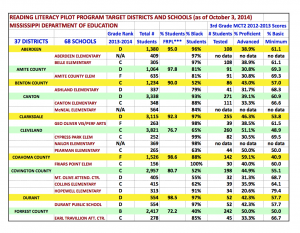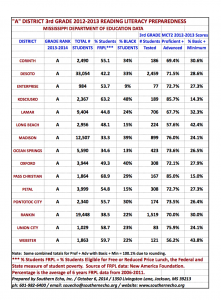And Why We Need Full Statewide Funding of Literacy Efforts


All Mississippians have a real stake in the fight to provide sufficient funding to fully implement the goal of the 2013 Literacy-Based Promotion Act to generate universal on-grade reading literacy by the 3rd grade.
The data shows that whether schools are higher performing or lower-performing, urban or rural, larger or smaller, majority white or majority black, higher wealth or lower wealth, and regardless of the geographic region in the state, there is a reading literacy crisis as revealed by 3rd grade Language Arts scores on Mississippi’s standardized tests.
3rd grade is the year students are supposed to make the transition from “learning to read” to “reading to learn”, which requires students be sufficiently proficient to read at grade level. Common Core standards have increased the necessity and heightened the urgency to effectively address the dilemma that Mississippi students score at or near the bottom when compared to other states and the District of Columbia. When students can’t read at grade level it also means they will have difficulty in coping with the grade level reading and writing necessary in their math, science and history classes.
Compounding the dilemma, the lack of literacy skills affects the willingness of students to stay in school and dropping out is a major step along the path from schoolhouse to jailhouse.
At the end of the 2014-2015 school year the reading literacy crisis will become most highly visible across the state when for the first time, as required by the Literacy-Based Promotion Act, elementary schools close the “3rd grade gate” to retain large numbers of students in the 3rd grade who are not Proficient in reading.
With this in mind, the Literacy-Based Promotion Act mandated that the MS Dept. of Education initiate a Literacy Pilot Program using literacy coaches and mentors to provide training, intervention and supports to administrators, teachers, students and parents to begin to address the goal of generating universal on-grade reading literacy. Unfortunately, the MS Dept. of Education reports that they have been able to hire only about 40 of the 72 literacy coaches and mentors the Dept. sought to employ for this program. In addition, the Pilot Program only involves approximately 15% of the state’s elementary schools.
To help visualize how extensive the problem, Southern Echo has provided two spreadsheets developed by the organization using data collected from the Mississippi Department of Education. One spreadsheet identifies each of the 37 school districts and 68 schools targeted in the MS Dept. of Education Literacy Pilot Program. This document shows how well or poorly the students in each district as a whole, and in each targeted school, have performed on the 2012-2013 MCT2 Language Arts exams. The spreadsheet also shows how many students were tested, the total enrollment in the district and each target school, black student percentage in the district and each target school, and the percentage of students in the district eligible for free or reduced lunch (as a measure of student poverty).
The other spreadsheet focuses on data for the 15 school districts that were ranked “A” districts by MDE for the 2013-2014 school year. This spreadsheet has the same kinds of data. None of these districts have schools that are among the targets in the MDE Literacy Pilot Program.
Taken together, the data in the two spreadsheets show the universality and depth of the reading literacy tramadol no prescription us pharmacy problem in the state.
What do we learn from the data?
· The target districts range from grade ranks of “B” to “F”.
· The target schools range from grade ranks of “B” to “F”.
· Whether the districts rank “A”, “B” or “C”, whether the schools rank “B” or “C”, there are high percentages and large numbers of students who in the 3rd grade cannot read at grade level. In short, the problem is not just based in underperforming “D” and “F” districts and schools.
· Do the “A” districts have better scores than lower-performing districts? Yes. But it is all relative and no cause for complacency. For example, consider this:
DeSoto County, an “A” district (the largest district in the state) tested 2,459 students in the 3rd grade in 2012-2013. The district, which is not a target district, had a relatively high score of 71% Proficient or above when compared to the target districts in the MDE Pilot Program. But that meant that 28.6% of the 3rd grade students … i.e. 703 students … read below grade level on the test. One quarter of the students in the 3rd grade read below grade level. That is a lot of students who need assistance with reading literacy! In an “A” district!
Jackson Municipal, a “D” district (the 2nd largest district in the state), a target district with 10 target schools in the Pilot Program, tested 2,300 students in the 3rd grade in 2012-2013. Jackson had a relatively high score of 49.6% Proficient or above when compared to the other target districts, but it was a lower score than any of the “A” districts in the state. This means that 50.5% of the 3rd grade students … i.e. 1,161 students … read below grade level on the test. Half of the students in the 3rd grade read below grade level. That’s daunting!
So – in these two districts alone, one an “A” district and the other a “D” district, one majority-white and higher wealth, one majority-black and lower-wealth, one in the northwest corner and one in the central part of the state, a combined total of 1,864 students did not read on grade level and, presumably, would need the intervention and supports now mandated by the Literacy Act.
That example involves only two of Mississippi’s 148 school districts. The state has over 400 elementary schools. We haven’t yet calculated the number of students reading below grade level in the 3rd grade statewide. But according to MDE officials as reported in the press, it is more than 40% of all 3rd graders.
The Literacy-Based Promotion Act targets every child in the state who is not reading on grade level by the end of the 3rd grade … and mandates that every such child receive sufficient intervention and supports beginning in K or 1st grade to enable the child to read on grade level.
A primary obstacle to success in this process will be insufficient appropriation of funds by the legislature and a consequent lack of implementation at the school level.
It is going to take a huge investment in resources to effectively train administrators and teachers, and provide meaningful intervention and supports to students and parents from K to grade 4 to enable students to progress to “reading to learn” on grade level.
It will be worth it. We need to fight for it!

